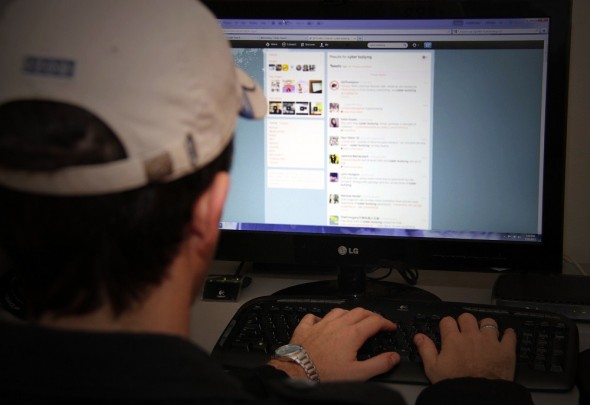I was sitting on the couch with some real friends ready for our weekly dose of Friends on TV when the phone rang. I answered. After a long pause, a voice whispered: “Leave him alone, leave him alooone.”
The voice was soft but the warning was loud and clear: stop seeing the Puerto-Rican 20-year-old Noel or my safety would be at risk.
We didn’t call it trolling back then, but bullying and anonymous threats have always been around.
The Australian Communications and Media Authority (ACMA) defines trolls as users who “intentionally cause distress, anger and argument in an online public forum for the purpose of disturbing other users”.
One in five young Australians receive hateful messages each year according to the Australian Institute of Family Studies, but it took attacks on high-profile celebrities before the issue received widespread mainstream coverage.
Rugby league player Robbie Farah received offensive tweets about his deceased mother and TV presenter Charlotte Dawson was repeatedly encouraged to end her life – and almost did so. In both cases, much has been said about their own far-from-perfect online behaviour, but it does not justify the vicious messages.
Trolls post inflammatory comments wherever they can, seeking attention while hiding behind a keyboard. Cyber bullies, a lot more common, usually know their target and make no effort to hide. Either type has an acute lack of respect for others and may not realise that their aggressive online messages can have real consequences.
“To every person who bullies, I have no respect for you. You’re the reason why I wanted to end my life,” read a note composed by a 16-year-old girl from Victoria before she killed herself. “Dumb, ugly, fat, whore, fag, retarded, skank” — these were only some of the names she had been called.
The Australian Bureau of Statistics reports that more than 2000 suicides occur each year. While motives and causes are not always clear, bullying is known to contribute to the problem. “My son tried to hang himself last night over bullies,” reads a mother’s post on a Facebook Suicide Prevention page.
Peter Jones* is determined not to let trolls disturb the thousands of users who visit the Facebook page he administers. He deletes hundreds of hateful messages posted daily on the ‘Gay Marriage Rights in Australia’ page. A recent example suggested that homosexuals “should be rounded up and slaughtered”.
Hatred is not a new phenomenon but social media is. High profile comedian Wil Anderson recently explained in a Triple M interview that “People have always said bad things behind people’s backs… but what people do on Twitter, is they’ll be mean, and they’ll include your name in there”.
So not only will you see the mean comment, but you will keep seeing it, again and again: there is no way to delete an @mention someone else has posted about you. It follows you, haunts you, and everyone else can see it too.
I’m glad social media wasn’t around during my teenage years. I could pretend I wasn’t aware of rumours about my sexuality and forget the ridicule I experienced when I showed up with green hair at school.
I could handle a few people pointing at me as I walked past; I don’t think I would have handled too well the kind of social media backlash many teenagers are exposed to these days. I can only imagine how hashtag #greenhair would have trended.
A recent study from Cornell University found that in spite of Facebook’s mission to “make the world more open and connected,” loneliness is on the rise at an unprecedented rate. An overwhelming 48 per cent of people have only one person they trust with their secrets, compared to an average of three confidants per person 25 years ago.
We are more connected with our social networks than ever before, with 200 million tweets and 2.7 billion “likes” and comments being posted each day on Twitter and Facebook. Yet the quality of these connections is clearly different from face-to-face conversations.
I try to limit my Twitter and Facebook use, but since it’s always in my pocket, I find myself checking it in the lift, by the photocopier, at my desk, by the water cooler and even as I’m running toward the closing doors of a train. Checking whether my friends have ‘liked’ my latest status or tagged me in an online comment has become a part of my offline life.
This is why there is no one-size-fits-all approach to address online harassment, bullying or trolling. Suggesting that trolling victims should remove themselves from the online environment and delete their accounts is a simplistic approach to a growing problem.
ACMA advises that the best way to deal with trolls is to ignore, block and report the troll.
Ignoring a troll is a good starting point. @MsCharlotteD is heavily criticised for having “fed the trolls” as she re-tweeted offensive messages she received to her 30-something thousand followers, spreading the poison. If trolls share offensive tweets with their handful of followers and no one replies, they’re more likely to go unnoticed.
However, as some incidents involve hundreds or thousands of trolls, ignoring, blocking or reporting them is easier said than done.
Australian cricketer Steve Smith has over 40 thousand followers on Twitter. He says he has received abusive messages in the past and “laughed them off” but that many other athletes “aren’t as thick-skinned and take it more personally”.
As for blocking someone on Twitter, if you’re anything like me, it will take you about five minutes to work out how to do it. Much quicker if you follow the instructions provided, but make sure you keep them nearby as a real troll is likely to create another account and target you again.
If a troll is more than a nuisance and becomes threatening or aggressive, it’s best to report this to the site administrators. Twitter’s rules state that users “may not publish or post direct, specific threats of violence against others”. Perhaps Twitter might give trolls a slap on the wrist for indirect threats too.
Anything more serious must be reported to law-enforcement agencies so they can pursue the matter and, most importantly, ensure your safety. Many actions performed by trolls would be classed as illegal under anti-discrimination, anti-vilification or defamation laws.
But how effectively can existing legislation protect Australians when radio personality Alan Jones can get away with suggestions that the Prime Minister should be “thrown out to sea in a chaff bag” and take no responsibility for his comments?
Professor Michael Fraser, from the Communications Law Centre at Sydney’s University of Technology, says that the Commonwealth Criminal Code spells it out very clearly: “Making a death threat using the internet or a carriage service is a criminal offence with imprisonment of up to ten years.”
Making someone apprehensive by “menacing, harassing or offending” is also a criminal offence that can result in up to three years’ imprisonment, said Professor Fraser.
Victoria Police is currently investigating online threats made on social media to council workers who enforce dangerous dog legislation. One comment posted about a female officer threatened to “tie her up and let the ants eat her”, followed by “hire a hit man and take the bitch out”.
Real action can only be taken with the cooperation of the social networking sites, unmasking those responsible. Following the recent debate after Robbie Farah spoke out, Attorney-General Nicola Roxon is now calling on Twitter to reveal the identities of trolls who abuse others online. “We need the assistance of US-based social networks, like Twitter,” she said.
But forcing Twitter to reveal the identity of its users could also have unintended consequences. Twitter was a main form of communication during the Arab spring uprising due to the possible anonymity it provided protesters who could otherwise not communicate inside a police state.
Much to the outrage of online privacy advocates, Twitter was recently forced to surrender more than three months’ worth of messages written by Occupy Wall Street protester Malcolm Harris who is being charged with obstructing traffic. Refusal to cooperate would see the social networking site face substantial fines and charges of contempt of court.
What is needed now is clarification of – and education about- social media ethics to make it clear that online actions have offline consequences. Cyber bullying is not a game.
Robbie Farah apologised recently for posting that a “noose” would be an appropriate gift for the Prime Minister. Like Farah, many of us may have been trolls at some point in our lives, as well as victims of trolling. We need to remind ourselves that there’s always time to pause and rethink before clicking send.
The absence of Twitter 12 years ago meant that my personal threat remained exactly that: personal. The voice on the phone didn’t humiliate me but it was enough to shake me. If Twitter had been around then, the message could have contained a lot more than “leave him alone” in 140 characters.
* Name changed to protect identity






Yeah, It’s a big problem now a days. But i believe every problem has a great solutions. Yeah, All of you are right. There is a good solution to parenting online to keep our child safe from such problem. It is a software called PG Guard. I have mentioned it’s features following. -PG guard is a simple to use service that safeguards children on facebook. -PG guard safeguards children regardless of devices they use or their location. -PG guard constantly monitors your child’s entire social environment. -PG guard uses unique artificial intelligence algorithms to profile each user. -Each social interaction is analyzed according to the profiles of the users involved. -PG guard informs parents of suspicious interactions in child’s social environment. -PG guard allows parents to educate, encourage and set boundaries online. for more details you can visit https://pgguard.com/ here